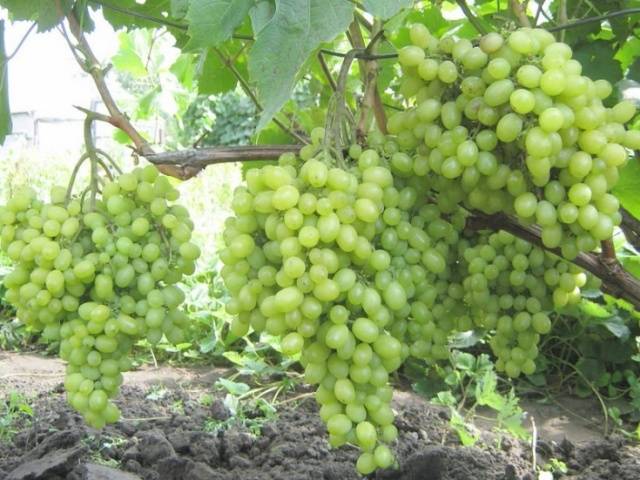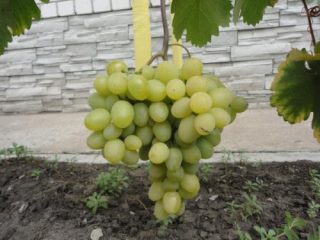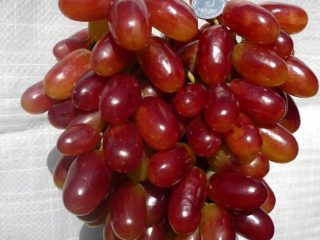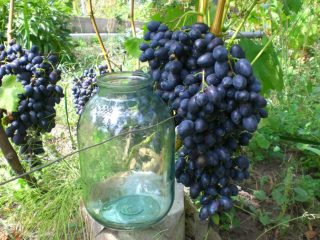Content
The Aleshenkin grape is a dessert variety bred in Volgograd more than 60 years ago. The plant has an average ripening period (late August) and resistance to winter temperatures. "Aleshenkin" is valued for its good taste, large clusters and attractive appearance.
The variety is actively grown throughout Russia. Before planting, it is recommended to read the description of the “Aleshenkin” variety, photos of grapes, and reviews.
Description
A detailed description of the variety is as follows:
- tall shrub with emerald-colored and medium-sized leaves;
- leaves have a smooth, glossy surface;
- bisexual flowers are formed on each shoot;
- grape cuttings quickly take root after planting;
- The lifespan of one branch is about 4-6 years.
"Aleshenkin" is a dessert variety that has good taste. Its berries meet the following characteristics:
- the shape of a bunch of grapes is a regular cone;
- the berries do not fit tightly together, which provides them with access to the sun's rays;
- the mass of the bunch reaches 2 kg or more;
- the berries are oval in shape, the average size is 21x25 mm;
- the weight of the berries is about 5 g;
- the grape pulp is juicy, the skin is of medium thickness;
- sugar content – 20%;
- 40% of berries are seedless;
- Up to 25 kg of grapes are harvested from one vine.
Variety resistance
The disadvantages of the Aleshenkin grape variety include the low resistance of the lower part of the plant to frost. Therefore, it is grafted onto more resistant rootstocks. The above-ground part of the grapes can withstand temperatures down to -26 degrees.
Yield indicators
"Aleshenkin" is a high-yielding variety. Its fruiting period is 6 years. As practice shows, sweet berries are collected from the bush for 20 years.
Then the fruiting of the grapes sharply decreases, and the plant is removed from the site. The next planting of grapes is carried out no earlier than after 3 years. During this period, the soil is restored.
If it is possible to completely replace the soil, then it is allowed to plant grapes after a year.
Planting and care
The Aleshenkin grape variety requires compliance with certain care rules. After planting, you need to water the plant, prune it and treat it against diseases and pests.
Choosing a landing site
For planting grapes, choose bright and warm places. “Aleshenkin” is unpretentious to the soil and location on the site, but following simple rules will help increase the yield and taste of the berries.
To grow grapes, soil preparation is carried out in autumn or spring. The soil must first be analyzed. With increased clay content, additional drainage is required.
If the vineyard is planted on peat soil, then sand must be added before planting.Sandy soil is fertilized with humus or compost.
Two weeks before planting, the soil is dug up to enrich it with oxygen. The location is chosen on the south or southwest side. To better warm the soil, it is recommended to plant grapes near the wall of the house. In the spring, the snow melts off faster on the south side, and in the fall, the soil begins to freeze later.
The Aleshenkin grape variety does not need to be planted between bushes or trees that create shade for it.
The variety is suitable for growing in film greenhouses. Grapes need access to sunlight, while excess moisture and shade are detrimental to them.
Landing rules
Planting and caring for grapes begins in the spring. During the summer and autumn, the plant will strengthen and be able to withstand the winter.
In autumn, the soil needs to be dug up and a hole 0.7 m wide and 0.8 m deep prepared. If it is located close to the groundwater surface, drainage must be arranged. Its functions will be performed by a layer of crushed stone 3 cm thick.
In spring, fertilizing for seedlings is prepared. It is obtained by mixing equal proportions of soil, river sand and humus. Then add nitrophoska and superphosphate in an amount of 50 g to the mixture. Before planting, pour a bucket of warm water into the hole.
If the grape cutting is located in a container, then you can immediately plant it to the prepared place. If the plant is placed in a plastic bag, then the cutting is first dipped into a zircon solution.This is a natural remedy that stimulates the growth of the root system. For 10 liters of water, 1 ml of the drug is required.
The seedling is placed at the bottom of the hole and buried halfway, after which it is watered with water and the top layer of soil is poured. Grapes are covered plastic film in which a hole is cut for the seedling. The material must be removed at the end of summer.
Spring and summer care
After planting, the vineyard is watered every two weeks. Each plant requires 4 buckets of water. If there is excess moisture, stop watering to avoid root rotting.
In the spring, cover is removed from the vineyard and damaged and old branches are removed. The vine is tied to a trellis.
Before the buds bloom, you need to fertilize the vineyard. The variety absorbs liquid fertilizers well: mullein solution, superphosphate, ash.
In summer, you need to pinch the vine at a height of 1.7 m. If the inflorescences are in the shade due to leaves, then they need to be removed.
With a lack of pollination, grape peas occur when the berries become very small. Therefore, the variety is additionally treated with growth stimulants.
In the future, the Aleshenkin grapes do not require fertilizing. After the rains, the soil is loosened. Watering is resumed in October to prepare the variety for wintering.
Bush formation
Due to bush formation Its productivity increases and branches that no longer bear berries are eliminated. The “Aleshenkin” variety is pruned in the fall, its sleeves are placed in a trench and protected from the cold.
When pruning, up to 16 buds are left on the branch.When forming young plants, you need to leave 4 shoots on the branch, which are tied to a wire in the spring.
On the branches from which the harvest was harvested last year, 3 buds are left. If all the buds wake up in the spring, then only the lower one is left. A special feature of the “Aleshenkin” variety is the presence of an inflorescence on the lower bud.
The formation of buds of the “Aleshenkin” variety occurs every year, but to obtain large clusters, only one inflorescence is left on the grapes.
Over time, the sleeves thicken, making them difficult to style for the winter. Therefore, it is recommended to form new sleeves and cut out the old ones. To ensure uniform ripening of the grapes, it is necessary to trim the upper sections of the bunch.
Prevention of diseases and pests
The “Aleshenkin” variety requires preventive treatment against diseases and pest attacks.
To prevent fungal diseases, bushes are sprayed with lime and growth stimulants. The variety is characterized by low resistance to oidium, so you need to treat the plant with Topaz. Ridomil Gold is used to protect grapes from mildew.
"Aleshenkin" is attacked by spider mites. This is a representative of arachnids that lives on the underside of grape leaves and feeds on their juices. Treatment of the variety against ticks is carried out in autumn or early spring. For this, phosphamide or nitrafen is used.
The root system of grapes is eaten by marbled beetle. You can get rid of the pest by introducing hexachlorane into the soil.
Reviews
Conclusion
"Aleshenkin" is an unpretentious variety that can withstand winter frosts. To plant it, winegrowers choose a sunny place next to the wall of a house or in a greenhouse. The plant requires constant care in the form of watering and the formation of bushes. Due to the average resistance to diseases and pests, preventive treatment of grapes is mandatory.



















